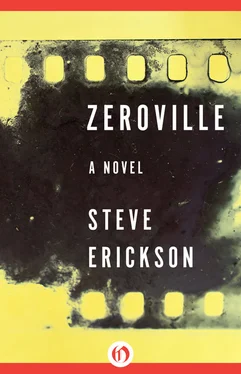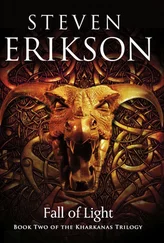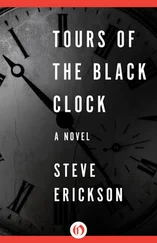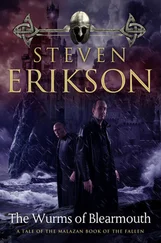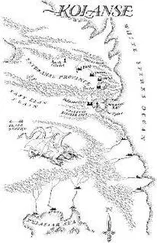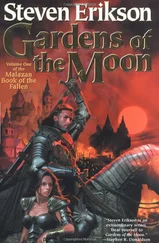Some panic seems to take hold of the art director. “There has been a change in the script?” He grabs a nearby telephone and dials. After a moment he says, “Elvira, it is Luciano. Have I received the, uh, last changes in the La Mancha script?”
“It’s not in the script,” says Vikar.
“Perhaps I should speak with Arthur,” Luciano says to Elvira on the other end of the phone.
“It’s not in the script,” Vikar repeats.
“Excuse,” Luciano says to Elvira, then to Vikar, “what?”
“I don’t believe it’s a very good movie,” Vikar says.
“Elvira, I will call you back.” Luciano hangs up the phone. “It is not in the script?”
“It’s twenty-three years after the script ends,” says Vikar, “she dies of consumption …” He taps the drawing. “… here.”
“Who says this?”
“Under this arch.”
“Who says she dies of consumption?”
“Every building has a back story and future story,” Vikar says. “Like an actor’s character.”
“This building is in the present.”
“The building is in all times. Every building is in all times and all times are in the building.”
92.
Dotty Langer says, “I hear you’re vexing them in set design over at UA.”
“I vex people,” Vikar acknowledges. “Have you ever heard of someone named Trane?”
They’re in an editing room on the Paramount lot. Dotty has about her a slightly boozy air, and a Jack Daniels bottle sits next to the moviola as before. “Is he in set design?” Dotty says. She opens a canister of film and begins spooling it through the moviola; she starts a cigarette. “Cut the light, will you?”
Vikar reaches over and turns out the light. In a moment, Montgomery Clift is on the small screen of the moviola, standing by the road trying to hitch a ride. Franz Waxman’s music rises up behind him over the moviola’s rattle.
93.
Montgomery Clift comes to town, the poor relation of a rich family that finds him a job at the local factory, where he meets and sleeps with Shelley Winters despite stern orders not to fraternize with the other workers. At a party he sees Elizabeth Taylor, the most beautiful of the local rich girls.
After twenty minutes, Dotty finally speaks. “Now watch this here,” she says. In the scene, Taylor and Clift dance. “Do you know what an editor does on a picture?” she turns to Vikar.
“Puts the scenes in order because they’ve been shot out of order.”
“That’s the first thing,” says Dotty. She stops the camera, Taylor and Clift mid-dance. “The editor also chooses which shot to use. In this scene here,” she waves her cigarette at Taylor and Clift, “something is happening that hasn’t happened in this picture until now.”
Vikar stares at the image. “A close-up,” he says.
“Very good.”
“I had to think about it awhile.”
She says, “It’s not something most people are aware of no matter how long they think about it — when the camera is close and when it’s far away. Those are the kinds of choices an editor makes.”
“Doesn’t the director make them?”
“It depends on the director. Most directors in pictures, up until the last ten or fifteen years, started off as writers or in the theater, so they concentrated on the actors and story. Your Mr. Preminger started in theater, Lubitsch and Welles started in theater. Sturges and Wilder started as writers — they really became directors just so they could protect their scripts from idiots. But Hitchcock was an art director early on, so he knew what he wanted his pictures to look like, and Von Sternberg and David Lean were, guess what, editors, so the same thing. Kubrick was a magazine photographer. Mr. Stevens started as a photographer too — though his parents were actors — then he was a cinematographer. He shot a lot of early Laurel and Hardy, of all things. You see what’s unusual here?”
“They’re dancing and we’re not seeing their bodies.”
“I’m impressed. The audience may not know it, but this picture’s been keeping them at arm’s length all this time. Monty has even slept with Shelley Winters from a distance. But as soon as Monty and Liz lay eyes on each other, the camera is pulling at the leash, it wants to get close. And now they’re dancing and we’re going crazy with the liquid dissolves, one image dissolving into the next. We’re getting tighter and tighter on their faces. No picture ever used close-ups like this one.”
“The first movie I saw in Los Angeles was a silent movie that’s all close-ups. An actress named Falconetti played Joan who’s burned at the stake.”
“O.K., smart guy,” she rolls her eyes, “no Hollywood picture.” She looks at him and says, “What happens next here?”
“Elizabeth Taylor stops and says they’re being watched.”
“And looks right at us when she says it. That’s how close we’ve gotten. The picture has crossed a line it hasn’t crossed before now — we’ve intruded. So Liz and Monty run out onto the terrace to get away from us. But they don’t get away from us, do they?”
Taylor and Clift are on the terrace in each other’s arms. In the background, all the other dancers and partygoers seem to fall away. The camera moves in so close on the lovers it can’t get all of their heads in the frame. “I’ve loved you since the first moment I saw you,” Clift says. “I guess maybe I loved you before I saw you.”
“Tell mama,” Taylor says. “Tell mama all.” Dotty stops the film, freezing it on an image similar to the one on Vikar’s head. She stares at it and pours a glass of bourbon, takes a drink and says, “Jesus, is this the sexiest moment in the history of movies?”
94.
Vikar says, “There’s hysteria in it.”
Dotty puts out the cigarette. “‘Vicar,’ huh?”
“With a ‘k,’” he decides.
“Does any man not fall in love with Elizabeth Taylor when she says that?” She points at Clift on the viewer. “Hell, Monty fell in love with her, and he liked boys, although there are people, people who would know, who insist he and Liz became lovers. Brando, he couldn’t have pulled off this scene—‘I loved you since before I saw you’? He would have read that dialogue and thrown up. There wasn’t another man who could have given himself over to this scene the way Clift does, because Monty did love her — he loves her in this scene and he loved her off screen and she loved him. ‘Tell mama all’—Liz was, you know, seventeen going on forever when this was shot. Liz didn’t want to say the line. She thought it was crazy any girl her age would say a line like that, and you know, she’s not wrong. And though most people wouldn’t believe it, I’m fairly certain she was still a virgin at the time. She even had made a picture with Mickey Rooney, for Christ’s sake, who brought to every picture he worked on a steely dedication to fucking his female lead. So Liz objected to the line but Mr. Stevens, who wrote it the night before, was adamant, because it was the only thing she could say that could match Monty’s intensity. Liz is a virgin, and Monty is queer, and you’re right, there’s hysteria in it, and with any other two actors on the planet, it wouldn’t be the same.”
95.
Dotty turns the scene back on. “If you watch closely,” she says, “you’ll notice something else. We’re cutting back and forth between Liz and Monty and none of the close-ups match up. We’re seeing them from one side, then the other, from one profile to the next, but in terms of sheer continuity it’s all fucked up. Mr. Stevens didn’t care about that. The D.P., Bill Mellor, is using a six-inch lens no one used until then, and Stevens was making the most of it, he was going for intimacy and rhythm — fuck continuity.”
Читать дальше
